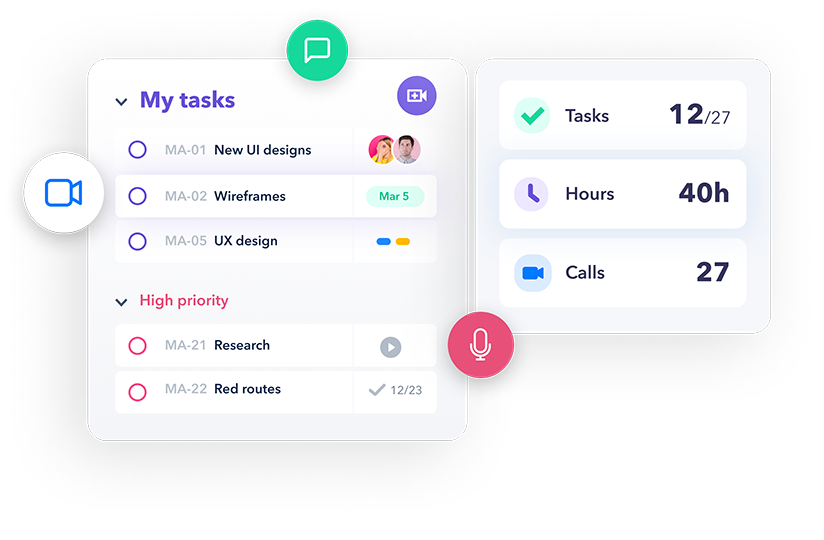Well before the pandemic, agencies were managing remote teams with freelancers and creatives. Throughout the pandemic more and more creative agencies moved towards a remote team management model but with that came the need to adapt. If your creative agency has recently moved to a remote team model or even if they’ve been one for a while, there is always room for improvement.
We’ve identified some ways that your remote creative team can work better together in order to accomplish client projects and tasks.

1. Centralize communication
The first casualty of remote work is direct interactions. To offset this, creative agencies should centralize all their communication, making it possible for seamless internal and external communication. But this doesn’t mean that you open multiple channels of conversations across platforms.
It will be overwhelming if you choose several modes of communication. As a creative agency manager, you should choose one or two channels. If something requires more than two emails, the solution should be a video call. Heycollab’s video calling can be used for impromptu meetings or scheduled team meetings for seeking clarification on specific projects or tasks.
2. Develop remote-friendly workflows
 In distributed teams, members can’t walk up to their managers to clarify their doubts or seek explanations on a campaign brief. So, on-site workflows and processes have to be reoriented to accommodate the challenges of remote work.
In distributed teams, members can’t walk up to their managers to clarify their doubts or seek explanations on a campaign brief. So, on-site workflows and processes have to be reoriented to accommodate the challenges of remote work.
How will you take briefs from the client? Will it be through a video call or email? Do you expect creatives to be a part of it? How will account management brief the creative teams? What’s the platform for creatives to communicate with each other? How will the creative product be shared with the client? Create a standardized procedure for all processes, both internal and external.
3. Make it transparent
Remote work can be confusing, especially in the beginning stages or when an employee is onboarded to the system. People may not know who their team members for a project are or who they should be sharing the work with. This can lead to needless back and forth and delays. The solution is to make all processes transparent in the system.
Different domains should know who would be working on a project and its sub-tasks. As a manager, it should be easy for you to assign tasks, review them, and give adequate support whenever necessary. Heycollab allows you to take additional responsibilities after assessing your workload. You can also assign projects and tasks to other team members.
4. Have scheduled meetings
Team meetings have always been important for organizations. But they’re particularly important during remote work. The key is to schedule these interactions and set a specific time and day. All meetings need not happen on a single day. That would be overwhelming for your team members. They can be divided over different days of the week to give time for employees to prepare.
For example, there could be a weekly discussion on current projects where creatives can share their work and others can give their inputs. There could be another allotted time slot for account management meetings. With Heycollab’s screen sharing, users can show their projects and tasks to get feedback in real-time. This keeps projects moving forward.
5. Focus on security
 Unfortunately, remote work can also make your digital assets vulnerable to hackers. Since there are multiple access points, you need to develop a security protocol to ensure the security of your systems. The first step is to mandate that employees shouldn’t use their corporate accounts for any personal use.
Unfortunately, remote work can also make your digital assets vulnerable to hackers. Since there are multiple access points, you need to develop a security protocol to ensure the security of your systems. The first step is to mandate that employees shouldn’t use their corporate accounts for any personal use.
If possible, it’s a good idea to encourage employees to use separate devices for work and personal use. Secondly, team members should be asked to watch out for suspicious emails. They should be instructed not to open attachments from unverifiable email accounts. Finally, access to accounts, shared drives, and software should be through two-factor and multi-factor authentication.
6. Encourage informal interactions
An office isn’t just a physical construct. It’s a collection of casual conversations and get-togethers, all of which are lost in the remote world. This can affect team spirit and the quality of work. If left unchecked, employees could become disengaged from work and start looking elsewhere.
Managers should be conscious of this potential alienation and encourage informal conversations between employees. One way is to hold meetings on non-work-related topics. It could be to discuss everything from sports events to movies. Another option is to encourage employees who wouldn’t normally interact to talk to each other. This can create a sense of being and help employees widen their social circles.
In short
These tips should enable creative agency teams to be agile and productive while working remotely.
————-
Heycollab is a project management tool built for teams like yours. With a free 14-day trial you can try out all the cool features. To get started visit https://heycollab.com/

